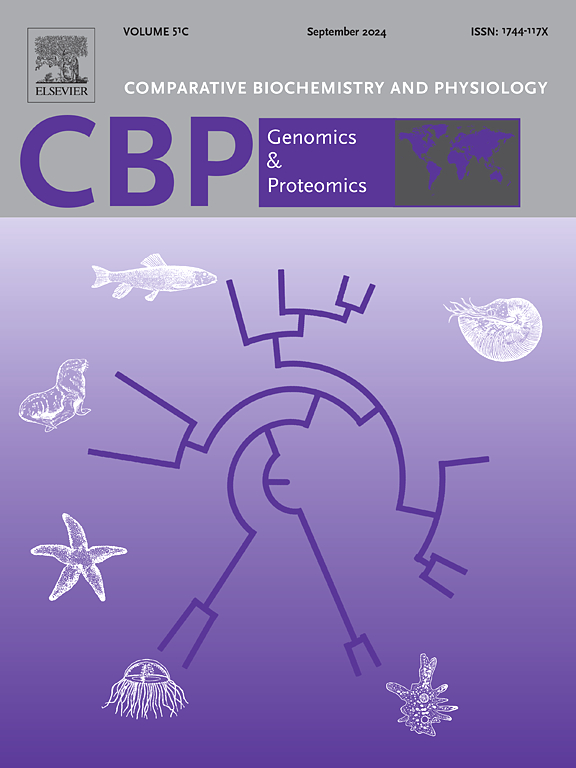Transcriptomics analysis provides new insights into the ovarian lipid droplet formation and lipid deposition in Plectropomus leopardus
IF 2.2
2区 生物学
Q4 BIOCHEMISTRY & MOLECULAR BIOLOGY
Comparative Biochemistry and Physiology D-Genomics & Proteomics
Pub Date : 2025-05-17
DOI:10.1016/j.cbd.2025.101534
引用次数: 0
Abstract
The leopard coral grouper (Plectropomus leopardus), an increasingly important species in marine aquaculture, has garnered significant research interest due to its high market value. Despite extensive research on ovarian growth and development in fish, the molecular mechanisms governing lipid droplet formation and lipid deposition in P. leopardus remain poorly understood. In this study, we conducted transcriptomic analyses of P. leopardus ovaries at three developmental stages: primary growth (PG), pre-vitellogenesis (PV), and mid-vitellogenesis (MV). A total of 534,847,090 raw reads were obtained from nine cDNA libraries, leading to the identification of 19,155 genes with 13,817 genes expressed at all stages. Differential analysis showed that 1012, 2609, and 4039 genes were up-regulated, while 168, 277, and 577 genes were down-regulated in the three comparisons, respectively. Functional enrichment analyses highlighting the critical roles of differentially expressed genes (DEGs) in lipid transport (such as fatp1, fatp4, fatp6, apoeb, lpl and fabps), fatty acid metabolism (such as elovl6, acsl1, dgat2 and gpat4) and phospholipid metabolism (such as ept1, chka and pla2g15). These findings underscore their contribution to lipid droplet formation and deposition. Furthermore, key signaling pathways, including Wnt, mTOR, PPAR and PI3K/Akt, were implicated in regulating these processes. The reliability of the RNA-seq data was confirmed through qPCR validation of 10 lipid-related genes. Based on these results, we propose a model for lipid droplet formation and lipid deposition during ovarian development in P. leopardus. This study advances our understanding of ovarian development in P. leopardus and provides a foundation for future research on marine fish reproduction, with potential applications in species conservation and aquaculture management.

转录组学分析为研究豹子卵巢脂滴形成和脂质沉积提供了新的思路
豹珊瑚石斑鱼(plectroomus leopardus)是海洋水产养殖中越来越重要的物种,由于其较高的市场价值而获得了重要的研究兴趣。尽管对鱼类卵巢的生长发育进行了广泛的研究,但对豹纹虾脂滴形成和脂质沉积的分子机制仍知之甚少。在这项研究中,我们对豹子卵巢的三个发育阶段进行了转录组学分析:初级生长(PG)、卵黄发生前(PV)和卵黄发生中期(MV)。从9个cDNA文库中共获得534,847,090个原始reads,鉴定出19,155个基因,其中13,817个基因在所有阶段表达。差异分析显示,三个比较中分别有1012个、2609个和4039个基因上调,168个、277个和577个基因下调。功能富集分析强调了差异表达基因(DEGs)在脂质转运(如fatp1、fatp4、fatp6、apoeb、lpl和fabps)、脂肪酸代谢(如elovl6、acsl1、dgat2和gpat4)和磷脂代谢(如ept1、chka和pla2g15)中的关键作用。这些发现强调了它们对脂滴形成和沉积的贡献。此外,包括Wnt、mTOR、PPAR和PI3K/Akt在内的关键信号通路参与调节这些过程。通过10个脂质相关基因的qPCR验证,证实了RNA-seq数据的可靠性。基于这些结果,我们提出了豹子卵巢发育过程中脂滴形成和脂质沉积的模型。本研究为进一步了解豹斑鳅卵巢发育提供了理论依据,为今后海洋鱼类生殖研究奠定了基础,在物种保护和水产养殖管理方面具有潜在的应用价值。
本文章由计算机程序翻译,如有差异,请以英文原文为准。
求助全文
约1分钟内获得全文
求助全文
来源期刊
CiteScore
5.10
自引率
3.30%
发文量
69
审稿时长
33 days
期刊介绍:
Comparative Biochemistry & Physiology (CBP) publishes papers in comparative, environmental and evolutionary physiology.
Part D: Genomics and Proteomics (CBPD), focuses on “omics” approaches to physiology, including comparative and functional genomics, metagenomics, transcriptomics, proteomics, metabolomics, and lipidomics. Most studies employ “omics” and/or system biology to test specific hypotheses about molecular and biochemical mechanisms underlying physiological responses to the environment. We encourage papers that address fundamental questions in comparative physiology and biochemistry rather than studies with a focus that is purely technical, methodological or descriptive in nature.

 求助内容:
求助内容: 应助结果提醒方式:
应助结果提醒方式:


